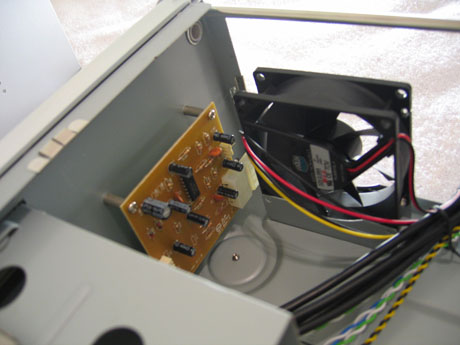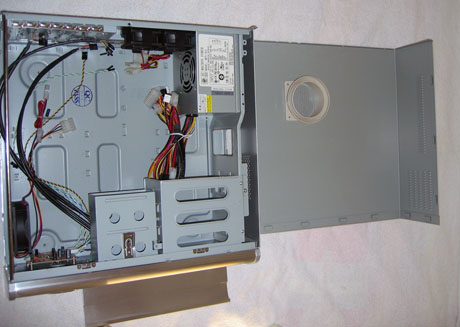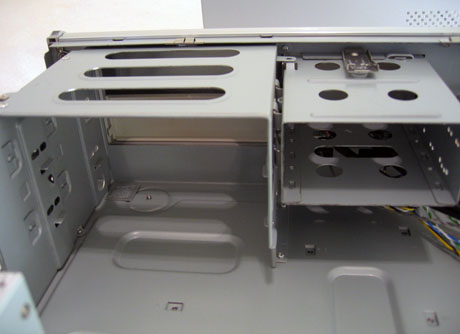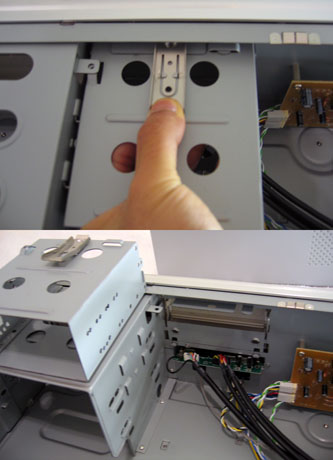December 2004 HTPC Case Roundup
by Purav Sanghani on December 27, 2004 2:00 AM EST- Posted in
- Cases/Cooling/PSUs
CoolerMaster Cavalier 2 (cont'd)
To remove the cover, we need to remove three screws at the back, then slide the cover back about an inch and lift up. Though not as tedious as the six screws that we dealt with on the D.Vine 5, we would like to see thumbscrews replace the standard ones. This can also be done by the user.Internal Design
Looking at the underside of the top cover, we see the vent that we noticed before opening up the Cavalier 2. There is also a circular duct, which will guide fresh air from the outside directly to the CPU heatsink fan. No matter the external temperature, the CPU will receive an "untouched", and definitely cooler supply of air.We took one look at the design of the chassis and realized it was almost exactly like the D.Vine 4 with a few minor variations. First, the 5-1/4" drive bays sit at the right of the chassis. To the right of those, however, we see a wall that splits the rest of the case from an inch wide section, which contains an extra 3-1/2" drive bay mount for a HDD.
Second, a removable dual 3-1/2" drive cage is placed in the same spot as on the D.Vine 4, but CoolerMaster has decided to make it even easier to remove by installing a tool-less device here. All we need to do is push down on the flexible steel clip and pull the drive cage back. There is also a tab with a screw hole to secure the cage further. We were disappointed that they made these bays external instead of HDD applications. A single external bay would have been more than sufficient, even if used as only a desktop PC.
To the left of the drive bays, we see the circuit board for the sound meter, as well as an 80mm fan mounted on the left side of the case where we saw the vent on the Cavalier's shell. This is an intake fan and blows air at the side of the 3-1/2" drive cage.
The motherboard tray in the Cavalier 2, like the D.Vine 5, supports both ATX and uATX boards as we see in the picture. There are plenty of holes available to use the screw-in stand-offs.
The expansion card slots, again like the D.Vine 5, are not tool-less, but then also again, we should not expect any of these features to be implemented in HTPC cases just yet.
Cooling
With the addition of an 80mm on the side, the Cavalier matches the D.Vine 5 with dual 60mm fans at the back behind the CPU area. Both are mounted as exhausts and help create a system that moves air from the front left side and out through the back.
The CPU duct that we mentioned earlier will also assist in bringing in air from the outside especially for the CPU heatsink. This should help cool the CPU by a few degrees.
CoolerMaster also includes a proprietary 300W Macron Power PSU, model MPT-301, which supports two SATA drives, four standard drives (MOLEX), two floppy drives, and also has a 6-pin P4 connector.
Construction
Since the Cavalier's body is made of steel, we searched for sharp edges around the inside. We did find a few around the drive bays and we advise users to take care during drive installations.Using steel will ultimately keep the price of the Cavalier 2 down, well below that of the D.Vine 5 in the end.














34 Comments
View All Comments
mcveigh - Tuesday, December 28, 2004 - link
mindless yes you can build a basic htpc with simple components, my current one is a 2.4P4 ATI 9100 radeon, and pVR 250 capture card.I want to do 2x resize with ffdshow and for that I'l need a 2.8 or faster processore and for some hardware assisted WMV acceleration I 'd like to get a 6600GT.
then if I want to convert videos to mpg or wmv for storage thats where my CPU will come into play more.
yes you can do basic functions with the essentials in a small case like hush pc does. but if you want all the bells and whistles, and not beign limited to 2-3 expansion slots you need a larger case.
Nintari - Tuesday, December 28, 2004 - link
You are absolutely correct on that you cant have it both ways. I do reviews and guides for HTPCNews.com and have experimented so much with different parts and etc and it took me a very very long time to setup such a powerful HTPC with such low noise and heat. Just so there is no confusion on this I was not sayign the CPU would be completely passive... the system can be set to turn off fans and run completely silent when idle (such is the case with cool n quiet on the AMD athlon 64 cpu, combine that with a systemboard liek the ones from Aopen that have built in fan control and your all set for silence and speed without sacrafice)Again as stated earlier you have your opinion on what a HTPC is and should consist of, others have the need for more power to do a lot more with thier HTPC than just basic DVD and PVR. I am not saying you are wrong ut I am stressing that it is incorrect to say that the system being used was overkill I for one find it hard to go back to DVD without ffdshow post processing, the capability to PVR HDTV and perform multiple recordings all at once on my HTPC and therfore find it nessecary for the power.
mindless1 - Tuesday, December 28, 2004 - link
You can't have it both ways though, a silent, passive heatsink inside the system increases need for passive airflow. Spec'ing out a system that has more power than it needs will ultimately produce more heat, need more airflow and either filters (which increase noise level per same flow rate) or a service interval. There's another area where passive theater equipment has an advantage, a passive (proper) design has fewer mechanical parts to break and longer service interval- It's not often one has to open up such equipment to dust it out.Nintari - Tuesday, December 28, 2004 - link
it is all a matter of selecting the rigth parts to work in conjuntion with one another. The AMD Athlon 64 CPU has the cool n quiet tech that can cool the cpu down so much in a optimal environment that the cpu fan can some times even shut it's self off. With the right cooler on the right video card that can be silent as well without using a passive heatsink to allow heat to build up in your case.Nintari - Tuesday, December 28, 2004 - link
You are incorrect I built a HTPC with a little bigger gaming card in it. I could have got the 6600GT but then I would not of been able to get a VGA silencer for it at all. The newer NVIDIA cards ahve excellent image quality for DVD movies or TV and ETC when using the NVDVD decoders read up on pure video). I actually cool everythign in my HTPC with ease at extremely low noise levels :) In other words when the room is dead silent I still barely hear my HTPC and that is only when I am on top of it. From across the room it is inaudible.I take it you have never ran WMV9 HD content, PVR HDTV content or used FFdshow resize to scale DVD to 1920x1080i to a HDTV set if you had then you would see why more CPU power in a a HTPC is required. I can on my HTPC record two SDTV shows and a HDTV show in the background while I watch a DVD....without the system flinching
mindless1 - Tuesday, December 28, 2004 - link
Nintari, high-end HT equipment is typically large only because it allows passive cooling. If it had audible fans too, it could/would be smaller.Again Nintari, you didn't build a HTPC, rather an entire gaming system that ALSO does HTPC functions. Perhaps the difference is in our individual interpretations of what a "HTPC" is... almost all of my boxes have a tuner/cap card of one vintage or another in them but I dont' go calling them all HTPCs.
No, you dont' want to have "as much CPU power, video performance and mmemory as possible". Well, ok, maybe some do, but it's a negative thing for a HTPC unless you're into the bigger/larger/faster/more-expensive is inherantly better mindset. Otherwise, many people prefer a cost, size, heat, noise optimized system. It would be impossible to cool the components you describe with < 30db of noise, yet some don't want 30db from a HTPC.
Perhaps my tone started out wrong. I'm not trying to tell anyone what they should do with THEIR HTPC, rather stating my opinion, and an evidence that there are those who aren't looking for just another almost-fullsized desktop system for a HTPC. The market is large enough it should support both extremes, many alternatives.
Nintari - Tuesday, December 28, 2004 - link
I have to agree with the others on this one... tests for noise levels should have been made with and without the rest of the fans on in the system..#17 mindless1: your post is your opinion and I will give you that but to say that these cases are too big is ridiculous. High end and mid range THeater equipment is not small by any means so some of these cases will fit in perfectly. Granted the depth of the cases is one of the worst thing on some of these especially on the D5 from Ahanix (which is excessivly deep). As to the hardware used that is not a total waste at all! Sure the 9800XT should have been used with a silent cooler such as a VGA silencer but really the system specs were good. Even when just using PVR and DVD in a decent HTPC you want to have as much CPU power, video performance and memory as possible especially when post processing DVD movies FFDshow, Playing back WMV9 clips or movies or other intensive tasks. I personally have a AMD A64 3200+ w/ Zalman CNPS7000A-Cu, Nvidia 6800 w/ VGA silencer, V@Box DTA 151 HDTV tuner, SB Audigy 2, Dual PVR cards 2x 300GB hard drives and a few other goodies in my HTPC. The noise levels are very very low and this system can do just about anything I want it to including scale DVD to HDTV levels (on DVDs that are encoded well) and play Half Life 2 and other games at High IQ & resolutions with AA and AF on!
mindless1 - Tuesday, December 28, 2004 - link
All of these cases are ridiculously large.They're not really suitable for HTPC cases at all, they're merely desktop cases instead of towers, with beautified bezels.
A 2U case is borderline "too big" for a HTPC case. If you can't get a HTPC built into that size or smaller you're doing something terribly wrong. Granted, some setups may require a PCI and/or AGP riser.
Now the hardware - Athlon 64, R9800XT, and 1GB of memory. RIDICULOUS. A complete and total waste, and inferior to appropriate hardware due to higher thermals and power requirements. This is not a HTPC, it's just the same old desktop system except median-tiered instead of high-end.
Now, if you actually do want to play games in your living room, so be it, but it's NOT a "HTPC" then, rather a gaming box with a tuner/cap card in it.
mcveigh - Tuesday, December 28, 2004 - link
I haven't handled the NMedia but it looks like similar cases out there from it's design and I think the silverstone looks nicer and of a higher quality.I want my htpc to look nice. I currently have an delr coolermaster aluminum case and most people don't realize it's a PC.
so i'm going with the minority and saying I loke the Silverstone :)
Mears - Monday, December 27, 2004 - link
Man, I wish the NMedia accepted a full ATX board. I'd buy it in a heart beat...